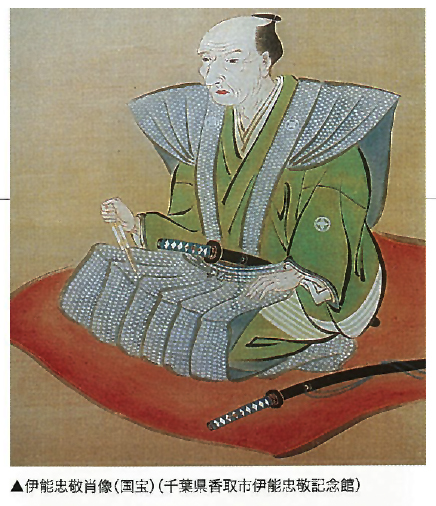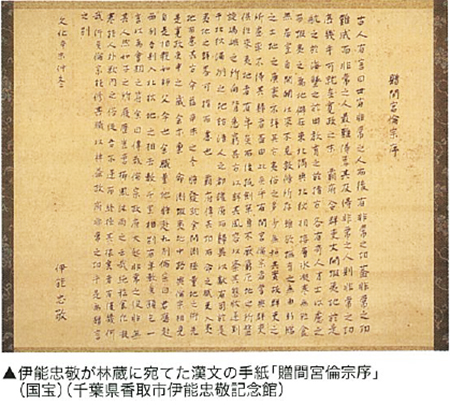


幕末期には列強によるアジア地域への「進出」という名の侵略行動が活発化した。江戸幕府によるオランダ・中国以外の国との接触を断つ鎖国政策に他国からの政策変更圧力が高まっていた。この時期に幕府は積極的に「北方探索活動」を推進しはじめる。間宮林蔵の仕事はそのなかでも「間宮海峡」という個人名まで付された、いわば世界が公的に追認した大きな成果だった。
この時代段階での地学測量の技術面の困難を克服しながら「国境画定」の基盤を為す行為。ロシアによるユーラシア大陸北東地域への進出制覇という脅威の現実があり、その情勢の中で、北海道島、樺太島が島嶼であるのか、大陸の延長であるのかはすぐれて国際関係論の重要テーマとされていた。
現実に各国の「探検家」たちが樺太と大陸の地理関係を探査してきていたが、失敗を重ねてきていた。鎖国体制とは言え、幕府もロシアの南下侵略行為への強い危機認識を持ち、国際的「公知」の根拠となる精細な地域測量努力を重ねていた。地理を正確に把握していることがそのまま強い「外交交渉力」となるのが、現代世界にまでいたる世界標準的「法の支配」根拠だったのだ。
こうした情勢下、幕府では写真のように北海道島の正確な地図作成目的で、伊能忠敬や最上徳内など旧来の幕臣ではない人材任用が行われた。かれらの行為は第一に日本国の国防の最前線活動だったのだ。そういうなかで世界に樺太の正確な地理知識を認定させた間宮林蔵の足跡は、ロシアに対する最重要な「抑止力活動」だったと言える。科学知識に基づく防衛装備。
間宮林蔵は幕府機構組織の中では「お庭番」という間諜活動に位置づけられ、事実としてかれの晩年にはその本来業務での活動事実も上げられている。幕府組織としては対ロシア国防での明確な功労者である間宮林蔵はいわば専門職として農民から抜擢登用した人物。伊能忠敬や最上徳内もその専門知識をもって幕臣の地位を与えた存在。したがってその本来の役儀である間諜活動を命じていたことになる。その後、明治の政変に至る過程で、その評価について歴史の荒波に揉まれていくことになる。

そういうかれら同士では、いわば身内意識、専門職としての共感があったことが記録にある。上の資料は伊能忠敬から間宮林蔵への書簡。高齢になってから農民身分を「隠居」した後「お国のために」測量活動を続けた伊能にしてみれば、若い間宮の行動にはいたわりの感情も持っていたように思う。事実、間宮は一人っ子であり生家は同族の人間によって家系存続されている。間宮林蔵個人は結局妻帯せず、いわば国事に人生を捧げることになった。その後の国の戦争での戦没者たちの影と重なってもみえてくる。
北海道人としては、こうした先人たちのことを忘れることはできない。
English version⬇
Promoting the national policy of “border demarcation” at the end of the Edo period – Rinzo Mamiya’s birthplace – 5
Geographical surveying to ensure the world standard “rule of law” basis. Deterrence activities that confronted Russia with the world standard “rule of law”. …
In the last days of the Edo period, invasive actions by the powers in the name of “expansion” into the Asian region became more and more active. The Edo shogunate’s policy of seclusion, which cut off contact with countries other than the Netherlands and China, was under increasing pressure from other countries to change its policies. During this period, the Shogunate began to actively promote “northern exploration activities. Rinzo Mamiya’s work was a major achievement that was officially recognized by the world, and was even given a personal name, “Mamiya Kaikyo.
The act of overcoming the technical difficulties of geological surveying at this stage of the history of the world and establishing the foundation for “border demarcation” was a major achievement. The reality was that Russia was threatening to conquer the northeastern part of the Eurasian continent, and the question of whether the islands of Hokkaido and Sakhalin were islands or extensions of the continent was an important topic of discussion in international relations.
In reality, “explorers” from various countries had explored the geographical relationship between Sakhalin and the continent, but had repeatedly failed. Despite the isolationist regime, the Shogunate also had a strong sense of urgency about Russia’s southward aggression, and made repeated efforts to survey the area in detail as a basis for international “public knowledge. The accurate understanding of geography was the basis for the world standard “rule of law,” which has continued to the modern world, as a strong “diplomatic bargaining power” as it is today.
Under these circumstances, the Bakufu appointed personnel not traditionally associated with the shogunate, such as Ino Tadataka and Mogami Tokunouchi, to create an accurate map of the island of Hokkaido, as shown in the photo. Their actions were first and foremost a frontline activity for the national defense of Japan. In this context, the footsteps of Mamiya Rinzo, who made the world recognize the accurate geographical knowledge of Sakhalin, were the most important “deterrence activity” against Russia. Defense equipment based on scientific knowledge.
Rinzo Mamiya was positioned as a counterintelligence agent in the Shogunate organization as “Oyaban,” and in fact, in his later years, his activities in his original duties were also reported. Rinzo Mamiya, a clear contributor to the defense of the Shogunate against Russia, was selected and promoted from among the peasants as a specialist, so to speak. Ino Tadataka and Mogami Tokunouchi were also given the status of shogunate vassals because of their expertise. Therefore, they were ordered to engage in counterintelligence activities, which was their original role. Later, in the process leading up to the political upheaval of the Meiji period, he was caught in the stormy waves of history regarding his evaluation.
The record shows that there was a sense of kinship and professional empathy among them. The above document is a letter from Tadataka Ino to Rinzo Mamiya. Ino, who had continued his surveying activities “for the good of the country” after “retiring” from the peasant life at an advanced age, seems to have felt some sympathy for the young Mamiya’s actions. In fact, Mamiya was an only child, and his family of birth was continued by a member of the same family. Rinzo Mamiya personally did not marry and devoted his life, so to speak, to national affairs. His life was dedicated to national affairs, so to speak, and his deaths in subsequent national wars can be seen in the shadows.
As a Hokkaido native, I cannot forget these predecessors.
Posted on 5月 19th, 2023 by 三木 奎吾
Filed under: こちら発行人です, 歴史探訪







コメントを投稿
「※誹謗中傷や、悪意のある書き込み、営利目的などのコメントを防ぐために、投稿された全てのコメントは一時的に保留されますのでご了承ください。」
You must be logged in to post a comment.